Table of Contents
|
The Village at Mid-Century
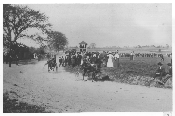 |
| Harness racing action at the
annual
Richmond Hill Spring
Fair. |
Richmond Hill proved
a mystery to
Richard
Bonnycastle as he gathered impressions for his book,
Canada and the Canadians in 1846. To this
British-trained military engineer, "the vaunted
Yonge Street mud road"
was little more than a "Slough of Despond," and
Richmond Hill itself
left much to be desired. The
Oak Ridges, wrote
Bonnycastle,
were "remarkable enough" and
Dalby's Tavern was
"a most comfortable resting-place for a wearied traveller. But of
Richmond Hill," he
concluded with a sigh of exasperation, "why so called I could never discover,
for it is neither very highly picturesque, nor very highly poetical."
1
William Henry
Smith, another mid-century chronicler of Canadian communities, at least
avoided the sweeping generalizations of
Bonnycastle.
But
Smith also
found
Richmond Hill a
challenge as he collected details for his 1852 book,
Canada: Past, Present and Future. Unlike
most villages and small towns in Upper Canada,
Richmond Hill lacked a
major intersection or "four corners" - with buildings such as post office,
bank, general store, and church - that told everyone where the centre was.
Richmond Hill, wrote
the perplexed
Smith, was "a
long village, stretching up and down the road for some distance. It is
difficult," he continued, "to calculate the number of inhabitants, the houses
being so scattered that it is scarcely safe to say what should be comprised
within the legitimate limits of the village."
2
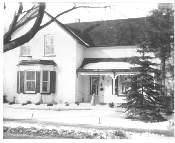 |
| A typical village house built in
the 1850s, located at
111 Richmond
Street. |
Both
Bonnycastle
and
Smith passed
on to other, more predictable communities, leaving
Richmond Hill to its
own peculiar existence. Had either visitor stayed longer, he might have counted
some two to three hundred people living in the village in the mid-1800s. He
might also have witnessed plenty of evidence of commercial activity along the
stretch of
Yonge Street, as well
as new church and school buildings - all of which indicated a degree of
community maturity.
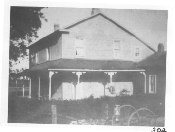 |
| The
Fulton/Vanderburgh House at
32 Hillsview
Avenue, dating from the 1840s. |
Smith at
least hinted at this when he summed
Richmond Hill up as
"a smart little place" before going on to describe
Thornhill, the next
community in his book.
3
What was this
"smart little place" like in the middle of the nineteenth century? As
Smith
suggested, the majority of its houses and shops were strung out along
Yonge Street, where
Lots 46 and 47 had been subdivided on both sides of the road to provide small
commercial and residential properties from
Major Mackenzie
Drive north to about
Wright Street. But
development had also begun to the west of Yonge, with a few homes along
present-day
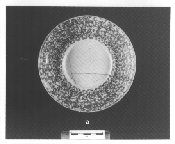 |
| Examples of eighteenth- and
nineteenth-century dinnerware, found on the
Fulton/Vanderburgh Site.Archaeological Services
Inc. |
Arnold,Centre,Richmond,Wright, and
Mill streets as far
west as the
Mill Pond, and east on
Church and
Centre streets.
It was a busy community. By 1851,
Richmond Hill boasted
eight storekeepers, five innkeepers, three blacksmiths, six
carpenters/cabinetmakers, three wagonmakers, a distiller, and three doctors.
The
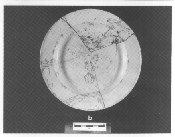 |
| Examples of eighteenth- and
nineteenth-century dinnerware, found on the
Fulton/Vanderburgh Site. Archaeological Services
Inc. |
Mill Pond to the west
housed a sawmill operation, while other streams beyond the village core
supported various gristmill and sawmill enterprises.
It was also a community that knew how to enjoy itself.
Everyone turned out for
Richmond Hill's first
spring fair, sponsored
by the recently formed
Yonge
Street Agricultural Society and held on the Queen's Birthday, the 24th
of May, 1849. Villagers flocked to the two-acre site southwest of
Arnold and
Yonge streets, while
crowds from the neighbouring countryside came in their horse-drawn buggies and
wagons.
"Since there was no public address system available,"
wrote community historian
Mary Dawson in later
years, "a man with a loud voice, mounted on horseback, made the rounds of the
hotels calling out the list of events, summoning the thirst quenchers to
participate."
4 Sheep and hogs were exhibited in pens,
poultry were shown in crates, and cattle were tied to fences. A tightrope
walker displayed his art on a rope stretched between two hotels on opposite
sides of
Yonge Street, while
horse races were held along the road itself.
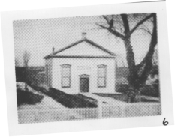 |
| Richmond Hill Methodist Church, dedicated on July 1,
1849. |
While the village's social life was getting livelier, the
churches of
Richmond Hill were
subsiding into a state of respectability. The transformation was especially
noticeable among the
Presbyterians. What a
change it must have been to move from the fiery tenure of
Reverend William
Jenkins to the conservative regime of
Reverend James Dick.Jenkins had
continued to preach both religious and political radicalism until his death in
1843. But once Reverend Dick began his thirty-year stint as pastor in 1847,
discussion seems to have focused more on choir stalls and organs than on
voluntarism, disaffection, and rebellion.
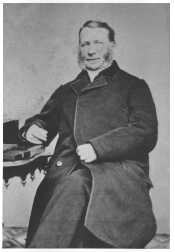 |
| Reverend James
Dick, minister of the
Richmond Hill Presbyterian Church, 1847-1877. |
Village
Methodists were also
forsaking their once-radical past. Gone were the circuit riders, the saddlebag
preachers and - except for special occasions - the open-air revival meetings
that had formed the backbone of Yonge Street Methodism in the early years of
the nineteenth century. Gone, too, were the years of meeting in settlers'
cabins or sharing sanctuary space with the
Presbyterians. In
1847,
Richmond HillMethodists hired
Reverend
Robert Campbell
as their resident minister and engaged
Thomas Harris as
architect to design a permanent
church building on the east side of
Yonge Street, about a
block north of the
Presbyterians.
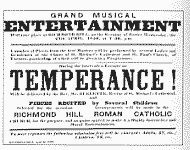 |
| Notice for a temperance lecture at the
Richmond Hill Roman Catholic Church in April
1859. |
Under the supervision of contractor
Uriel
Chamberlain, a frame of massive timber was soon erected and closed in.
Even though the plastering of walls had not been completed, the
church was opened and dedicated on July 1, 1849. Soon
afterwards, the pews were finished and the tallow candles were replaced by gas
lights.
5 Other denominations followed suit: the
Roman Catholics
built a
church on
Mill Street in 1857 and
the
Anglicans built
one on
Yonge Street, south of
the
Presbyterians, in 1872.
Meanwhile, the Monday-to-Friday life of
village youngsters was being regulated with increasing efficiency. Throughout
all of Upper Canada from the mid-1840s on, common schooling shifted away from
tuition fees to public funding, and family control of education was gradually
replaced by a publicly administered system.
Richmond Hill's
children moved from their old log school building to a new brick schoolhouse in
1847. The
Richmond Hill
Public School was administered by the elected trustees of
Union School
Section No. 3 of
Markham and
Vaughan townships.
This and other "union" school sections formed by local ratepayers along
Yonge Street both
south and north of the village centre helped break down the administrative
division between
Markham and
Vaughan townships
and gave some feeling of commonality to
Richmond Hill
residents.
 |
| Richmond Hill
Public School, opened in 1847, pictured in a 1908
photograph. |
There was no secondary schooling in
Richmond Hill until
1851, when "grammar school" classes began in a private residence. Two years
later the
Richmond Hill
Grammar School moved into a building adjoining the
public school
and employed Reverend
James Boyd as its
headmaster. Boyd was a busy man, teaching all week in
Richmond Hill, then
serving as Presbyterian minister in
Markham on
Sundays. Still, he found time to develop a new approach to teaching geometry
that was accepted by the provincial education authorities.
6 But like so many nineteenth-century
schoolmasters and clergymen, Boyd's stay in
Richmond Hill was
brief; after four years he moved on to another church position in Waterloo
County.
Village residents also
concerned themselves with the continuing education and enrichment of the adult
mind. The
Richmond
Hill Library Association held its inaugural meeting in December 1852,
and guaranteed a highly respectable and moral tone for its work by electing
Presbyterian minister
James Dick as its first
president. Twenty-one months later, the association reported 357 books on the
shelves but only ten out to borrowers!
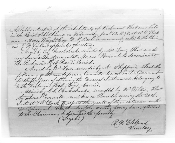 |
| Record of the founding of the
Richmond Hill
Band in 1853. |
The decade of the 1850s also
gave birth to the community's first newspaper. The
York Ridings Gazette and Richmond Hill Advertiser made
its debut on June 12, 1857, with
William Trudgeon
as manager and editor, using lines from the poet Lord Byron to proclaim its
mission: "With or without offence to friends or foes / We sketch the world just
as it goes." Within two years, however, economic realities forced the newspaper
through a number of name and ownership changes, while local political realities
encouraged it to support Liberal policies and programs. Still, the revamped
York Herald of
March 25, 1859, now under the editorship of
Malcolm McLeod,
could still sport such a lofty motto as "Let sound reason weigh with us more
than public opinion."
Notes
1.
Sir Richard Henry Bonnycastle,Canada and the Canadians in 1846,vol. 1(London: Henry Colburn,1846),pp. 185-87.
2.
William Henry Smith,Canada: Past, Present and Future(Toronto:Thomas Maclear,1852),p. 287.
3.
Ibid.
4.
The Liberal,May 11, 1977.
5.
G. Elmore Reaman,A History of Vaughan Township(Toronto:University of Toronto Press,1971),p. 205.
6.
Reverend James Boyd,"Memoir of the Rev. James Boyd of Crosshill,
Ontario, 1814-1888" (N.P: n.d.),
p. 6.
Previous
Next
Copyright © Richmond Hill Public Library Board, 1991
|

